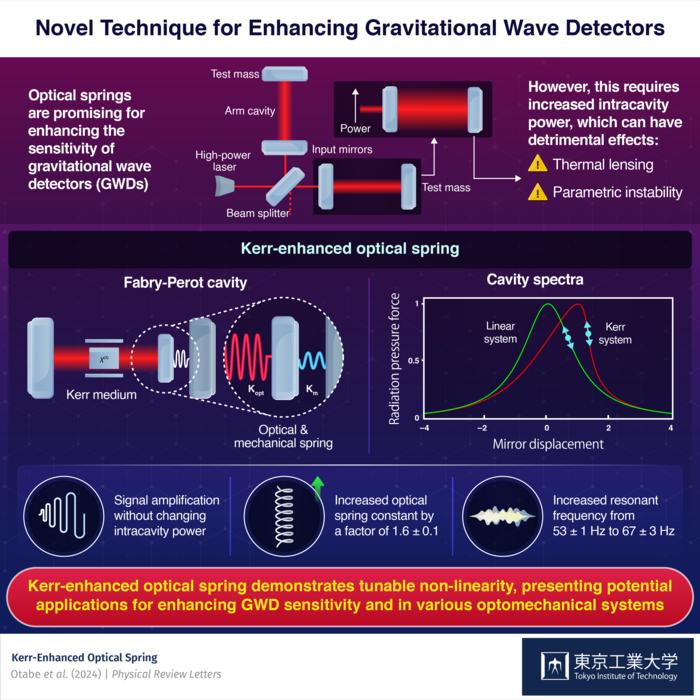Reviewed by Lexie CornerApr 8 2024
The discovery of gravitational waves is among the greatest triumphs of contemporary science. The first detection of gravitational waves in 2017 resulted from the merger of a binary neutron star, and this discovery revealed important details about the universe, including the production of heavy elements and the source of brief gamma-ray bursts.
 Kerr-enhanced optical spring demonstrates tunable non-linearity, presenting potential applications for enhancing GWD sensitivity and in various optomechanical systems. Image Credit: Tokyo Institute of Technology
Kerr-enhanced optical spring demonstrates tunable non-linearity, presenting potential applications for enhancing GWD sensitivity and in various optomechanical systems. Image Credit: Tokyo Institute of Technology
However, because the gravitational waves coming from post-merger debris have a frequency range outside of what current Gravitational Wave Detectors (GWDs) can detect, their detection has remained elusive.
Next-generation Gamma-Ray Doppler detectors (GWDs) are desperately needed because these elusive waves, which can only be spotted once per few decades by current GWDs, provide crucial information about the internal structure of neutron stars.
An optical spring can be used to amplify the signal and increase the sensitivity of GWDs. Unlike their mechanical counterparts, optical springs imitate the behavior of springs by using the radiation pressure force of light. The light power inside the optical cavity affects how rigid optical springs, such as those in GWDs, are.
Therefore, raising the intracavity light output is necessary to increase the resonant frequency of optical springs. This may, however, have detrimental thermal consequences and interfere with the detector's ability to function.
A group of Japanese scientists led by Associate Professor Kentaro Somiya and Dr. Sotatsu Otabe of Tokyo Tech's Department of Physics created a novel remedy for this problem in the form of the Kerr-enhanced optical spring.
A promising method to enhance the impact of optical springs without increasing intracavity power is intracavity signal amplification. This technique enhances the signal amplification ratio of the cavity by using non-linear optical effects and enhances the optical spring constant. Our research revealed that the optical Kerr effect is a promising approach for successfully utilizing this technique.
Kentaro Somiya, Associate Professor, Department of Physics, Tokyo Institute of Technology
The findings were published in the journal Physical Review Letters. This letter has been chosen as an Editors' Suggestion, a weekly award designed to encourage multidisciplinary collaboration.
This novel design produces an intracavity signal amplification effect by putting a Kerr medium inside an optomechanical cavity of the Fabry-Perot type. The medium's refractive index is altered by an optical field due to the optical Kerr effect that the Kerr medium causes in the cavity. As a result, the radiation pressure force in the cavity is introduced with a sharp gradient, improving the optical spring constant without raising the intracavity power.
Experiments have shown that the optical Kerr effect effectively increases the optical spring constant by a factor of 1.6. The optical spring's resonance frequency was raised from 53 Hz to 67 Hz. The researchers expect the signal amplification ratio to increase once technological issues are resolved.
The proposed design is easy to implement and provides a novel tuneable parameter for optomechanical systems. We believe that demonstrated technique will play a key role not only in GWDs but also in other optomechanical systems, such as in cooling macroscopic oscillators to their quantum ground state.
Dr. Sotatsu Otabe, Department of Physics, Tokyo Institute of Technology
This new optical spring design is a big step toward realizing the full potential of upgraded GWDs that can solve the secrets of the universe and optomechanical systems.
Journal Reference:
Otabe, S., et al. (2024) Kerr-Enhanced Optical Spring. Physical Review Letters. doi.org/10.1103/physrevlett.132.143602